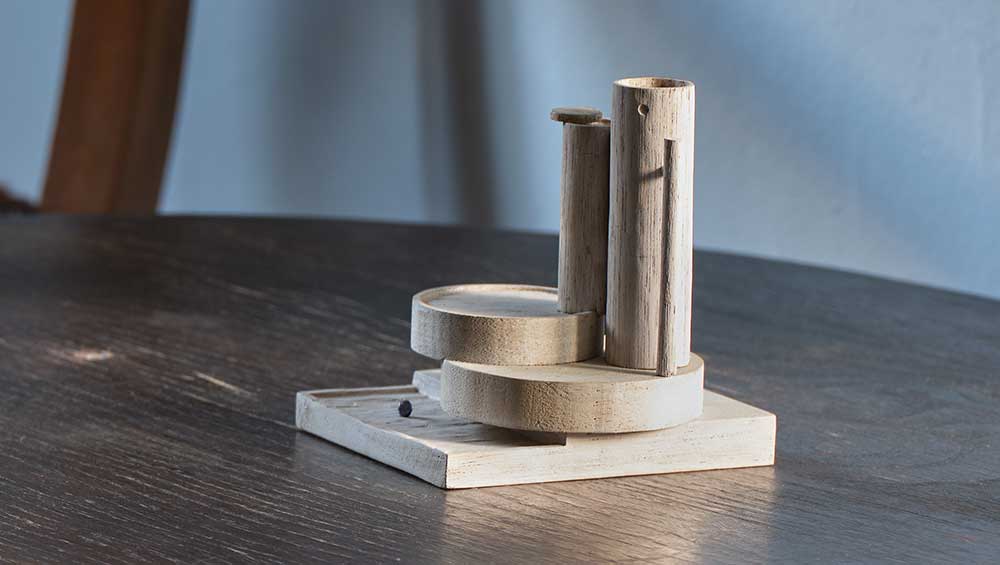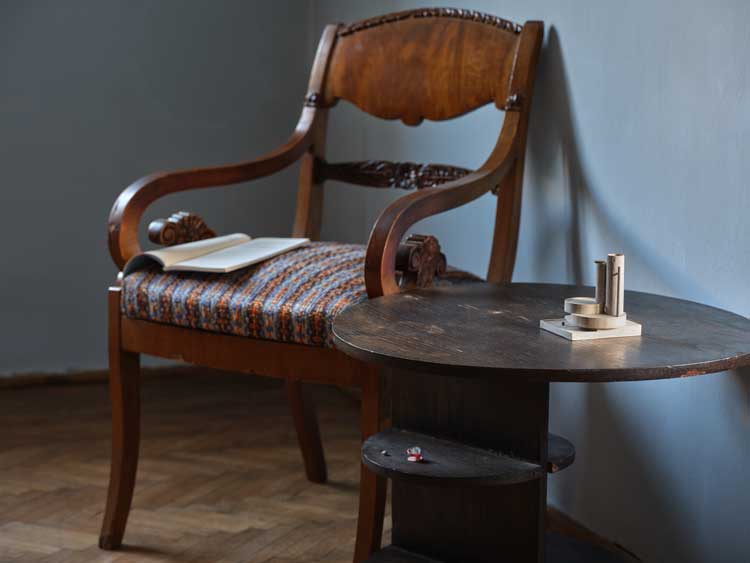
Kenji Ide: Some other times. Władysław Broniewski Museum, Warsaw. Photo: Bartosz Zalewski.
Władysław Broniewski Museum, Warsaw
26 September – 19 October 2024
by JOE LLOYD
On opening the front door of the Władysław Broniewski Museum and peering through the hallway to the garden behind, you may not notice the objects of Kenji Ide (b1981). Or you may assume them to be part of the furniture. The Japanese artist creates minute wooden objects, sometimes expanded with iron, wax, paper and sundry found materials. Ide often uses lauan wood, typical in Japanese furniture, which he sometimes paints with watercolour and acrylic varnish. But his creations look incredibly delicate, and almost as intricate. At the Broniewski Museum – a neoclassical villa in Warsaw’s well-heeled Mokotów district, where the eponymous poet spent the last nine years of his life — Ide’s artworks are disguised as ornaments.
.jpg)
Kenji Ide: Some other times. Władysław Broniewski Museum, Warsaw. Photo: Bartosz Zalewski.
The exhibition is presented by Warsaw-based Galeria Wschód, which has branches in New York and Cologne. It features 15 of Ide’s pieces, all made this year, spread through the house’s sitting room, bedroom, hallway and landing. Some are placed prominently, such as atop the poet’s piano and on his worn mattress; others are more discreet, hiding on side tables and windowsills. Most have a sort of quiet presence. Alongside his own creations, Ide has chosen to display items from the poet’s archive. The most prominent is a walking stick, leaning on a daybed as if Broniewski’s ghost is about to rise for a stroll.
-detail.jpg)
Kenji Ide: Some other times. Władysław Broniewski Museum, Warsaw. Photo: Bartosz Zalewski.
Ide’s works each reference a single incident or place. They seek to capture the beauty of brief moments, a concern in Japanese art since Sei Shōnagon’s Pillow Book (1002). Ide works with a language of spheres, discs and cuboids which, though it appears abstract, has figurative references. People are represented by balls, or by balls stacked on top of columns. Sticks with little circle protuberances depict falling raindrops. A Detour to Remember You, which sees two balls in one section and another slightly smaller one placed above, is a memory of himself and his wife at night with their child sleeping separately; a piece of the child’s old pyjamas is placed atop the piece like a bed.
In Japanese, Ide calls his works “objects” rather than sculptures; this might both imply an intimacy and refute the questing after permanence that statues often represent. As well as the named work, he has scattered the villa with things from his collection of found bits and bobs – coins, leaves, dried bird droppings – often placed at a height where they could connect with children. There are little carved wooden boots placed in hidden nooks. The exhibition experience feels like a treasure hunt. As an adult-size human, I sometimes had to kneel on the floor to scrutinise the work.
-detail.jpg)
Kenji Ide: Some other times. Władysław Broniewski Museum, Warsaw. Photo: Bartosz Zalewski.
Childhood plays an important role in Ide’s work. He claims to have found his metier aged five, after entering a labyrinth of cardboard boxes at his brother’s preschool art display. It felt like a different world. “I decided,” he writes in a diary entry translated for the show, “that I would capture moments like that one.” But it took many years, including fruitless teenage days spent staring at the sea, for him to find the means to put these desires into action. The act of walking has since become a key inspiration. Philosophers from Aristotle to Nietzsche walked to facilitate their thinking. Ide does the same, particularly at night.
He is interested in the films of Wim Wenders – an exhibition earlier this year at Adams and Ollman, in Portland, Oregon, was titled after The American Friend (1977) – particularly The Wrong Move(1975), Wenders’ road movie adaptation of Goethe’s Wilhelm Meister’s Apprenticeship (1795-95). Many of Ide’s works are based on memories of walks and drives, along with other occasions. And as in Wenders’ films, the journeys his art memorialises are not always straightforward. One piece in dark wood resembles a road that bends back on itself. Another is like a track from a carting game, twisting and winding around. Indeed, his works have a toy-like quality. Many feature apparently precarious positioning: orbs at the top of a slope, segments stacked atop each other that could topple at any moment.
.jpg)
Kenji Ide: Some other times. Władysław Broniewski Museum, Warsaw. Photo: Bartosz Zalewski.
Ide’s works also have an architectural aspect, with walls and floors; they could be miniature depictions of a built environment. Despite their personal nature, they allow for a universality. Watching the moon, taking a drive at night: Ide invites you to join him for these simple pleasures. With this exhibition, he also sought to communicate with Broniewski. The title work, displayed prominently on the living room table, represents an explicit doubling. We see two pieces of wood carved to create the outline of a crescent, with a ball placed on top. One of Ide’s anthropomorphic columns gazes at one and a hand at the other. It depicts both the artist and the poet gazing at the moon, though, hand aside, it could also be a geometric abstract.
The connection between Ide and Broniewski is not immediately apparent. Ide writes: “My sculptures are a diary put at a house of a Polish writer. It does not matter that I find it hard to pronounce his name.” A socialist, soldier and patriot, Broniewski was a poet of great promise. But in the 1940s he became a propagandist voice for Stalinism. There is an enormous bust, in socialist realism style, in the sitting room, its dimensions swamping the domestic context. He was garlanded with awards. Yet happiness was harder to achieve. He was an alcoholic. The death of his film-maker daughter Joanna by gas poisoning plunged him into despair.

Kenji Ide: Some other times. Władysław Broniewski Museum, Warsaw. Photo: Bartosz Zalewski.
A paternal instinct is one of the things that links the two. Simple Relationship (2024) features three figures of various heights, huddled together on a platform. Ide also has an interest in literature. He has placed an excerpt from a late work by Rashōmon author Ryūnosuke Akutagawa, written shortly before the writer’s suicide, on Broniewski’s bedroom chair. One of its characters says: “I just felt like riding around.” And Ide’s works, with their winding tracks and pinball machine-like apertures, express a pleasure in movement. Yet they also have a stillness. The title work is surrounded by three pebble-like globes, evoking the stony beds of a Zen garden. This is an exhibition that, to a rare degree, allows space for contemplation.